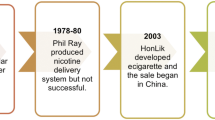Abstract
Using recently available data spanning four decades, this paper examines the determinants of smoking prevalence in Japan. Main contributions include (i) examining differences across demographics; (ii) studying the effect of intra-household spousal economic power on smoking; and (iii) providing evidence on the efficacy of the Framework Convention on Tobacco Control (FCTC). Results show that higher cigarette prices are more effective at reducing smoking prevalence among males than females, with significant differences across age groups. Greater economic prosperity and FCTC also deter male smoking, as does a higher relative income share of the wife in the household.



Similar content being viewed by others
Notes
According to projections by the International Monetary Fund, “By 2025, there will be roughly one elderly person for every two persons of working age, which will leave Japan with a higher old-age dependency ratio than any other major industrial country”, (http://www.imf.org/external/pubs/ft/fandd/2001/03/muhleise.htm).
See JT (2009).
According to the manual for investigation of smoking rates implemented by JT, no distinction was made between cigarettes and other types of tobacco. Thus, we take cigarette prices to proxy for overall tobacco prices or alternately, one could envision the smoking rates to be capturing mostly cigarette smoking.
The data for the monthly incomes is obtained from the Annual Household Consumption Survey released by the MIC, and is available for different age groups based on the age of household head, corresponding to the age groups.
Further, the level of aggregation in the data prevents us from identifying individual smokers and classifying them based on gender and other individual attributes. Availability of micro-level details could enable one to consider additional aspects of gender smoking differences.
The CPI for general goods is used as the deflator.
Relative significance of male smoking determinants was also found in the case of Taiwan by Lee et al. (2004).
Relatively greater effectiveness of smoking control initiatives in the elderly has also been found for the United States (Goel (2008)).
In general, it is not easy to do an overall cost-benefit analysis of implementing gender- and age-specific smoking-control policies. Future technological advances might enable governments to better target certain groups of smokers, while at the same time reducing related monitoring and compliance costs.
We thank a referee for suggesting these extensions.
References
Baltagi BH, Levin D (1986) Estimating dynamic demand for cigarettes using panel data: the effects of bootlegging, taxation and advertising reconsidered. Rev Econ Stat 68:148–155
Cebula RJ, Foley M, Houmes R (2011) Empirical analysis of the impact of cigarette excise taxes on cigarette consumption: estimates from recent state-level data. J Econ Financ, 2011, in press
Chaloupka FJ, Laixuthai A (1996) U.S. trade policy and cigarette smoking in Asia. NBER working paper # W5543, April 1996
Chaloupka FJ, Warner KE (2000) The Economics of Smoking. In: Culyer AJ, Newhouse JP (eds) Handbook of health economics, vol 1. North-Holland, Amsterdam, pp 1539–1627
Gallet CA, List JA (2003) Cigarette demand: a meta-analysis of elasticities. Heal Econ 12:821–835
Goel RK (2008) Smoking prevalence in the United States: differences across socio-economic groups. J Econ Financ 32:195–205
Goel RK, Nelson MA (2005) Tobacco policy and tobacco use: differences across tobacco types, gender and age. Appl Econ 37:765–771
Goel RK, Nelson MA (2008) Global efforts to combat smoking. Ashgate Publishing, Aldershot
Goto R, Nishimura S, Ida T (2007) A conjoint analysis on non-smoking intentions (Kinenishi ni kansuru conjoint bunseki). Welfare Index (Kosei no shihyo), September 2007, 38–43
Haden K (1990) The demand for cigarettes in Japan. Am J Agric Econ 72:446–450
Igarashi A, Ikeda S, Goto R, Kiyohara Y, Miura H, Takahashi Y, and Nishimura S (2008) Effects of tobacco tax increase on total tax revenue: a conjoint analysis (Tobacco zouzei ga souzeishou ni oyobosu eikyou no suikei: conjoint bunseki ni motoduku suikei). Smok Control Sci (Kinen kagaku) 2: 25–35
Japan Tobacco Inc. (JT) (2009) Fact sheets from annual reports
Kawate M (2009) The present situation and problems in Japanese tobacco tax system (Tabacoozei no genjo to kadai). Economy Prism (House of Councilors Japan) (66):23–33
Lance PM, Akin JS, Dow WH, Loh C-P (2004) Is cigarette smoking in poorer nations highly sensitive to price?: Evidence from Russia and China. J Heal Econ 23:173–189
Lanoie P, Leclair P (1998) Taxation or regulation: looking for a good anti-smoking policy. Econ Lett 58:85–89
Lee J-M, Hwang T-C, Ye C-Y, Chen S-H (2004) The effect of cigarette price increase on the cigarette consumption in Taiwan: Evidence from the National Health Interview Surveys on Cigarette Consumption. BMC Publ Health 4:1–7
Reports of the Tax Commission (Zaisei chosakai hokokusho) (1999). Japanese Cabinet Office
U.S. Department of Health and Human Services (2000) Reducing tobacco use: a report of the surgeon general. Atlanta, GA, Centers for Disease Control and Prevention
Wan J (2006) Cigarette tax revenues and tobacco control in Japan. Appl Econ 14:1663–1675
Wooldridge JM (2007) Econometric analysis of cross section and panel data. MIT, Cambridge
Yorozu I, Zhou Y (2002) The demand for cigarettes in Japan: impact of information dissemination on cigarette consumption. Contemp Econ Policy 20:72–82
Acknowledgments
Zhang acknowledges the hospitality of the Department of Economics at Illinois State University during a sabbatical leave that made work on this research possible. We thank three referees for useful comments.




